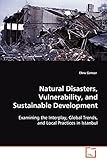Natural disasters, vulnerability, and sustainable development: examining the interplay, global trends, and local practices in Istanbul/ Ebru Gencer
Material type: TextPublication details: Germany: VDM Verlag, 2008Description: xviii, 418 p. : ill. ; 24 cmISBN: 9783836475105Subject(s): Natural Disasters | Cities and Town | Sustainable DevelopmentDDC classification: 363.34
TextPublication details: Germany: VDM Verlag, 2008Description: xviii, 418 p. : ill. ; 24 cmISBN: 9783836475105Subject(s): Natural Disasters | Cities and Town | Sustainable DevelopmentDDC classification: 363.34 | Item type | Current library | Call number | Status | Date due | Barcode | Item holds |
|---|---|---|---|---|---|---|
|
|
Central Library, Sikkim University General Book Section | 363.34 GEN/N (Browse shelf(Opens below)) | Available | P08458 |
Chapter 1: Introduction
1.1 Research Questions and Methods
1.1.1 A Quantitative Study on Twenty Countries
1.1.1.1 Research Design and Data Collection
1.1.1.2 Analysis of Data and Limitations of Study
1.1.2 A Qualitative Study in Istanbul, Turkey
1.1.2.1 Research Design and Data Collection
1.1.2.2 Interviews and Limitations of Study
1.2 Theoretical Framework and Significance
1.3 Outline of the Book
Chapter 2: Natural Disasters and Risk Management: A Conceptual Foundation
2.1 Definitions
2.2 Emergence and Development of Hazards and Disaster Research
2.2.1 Emergence of Hazards Research in Geography
2.2.2 Emergence of Disaster Research in Sociology
2.2.3 Hazard Paradigm (Hazard Adjustment, Behavioral, or the
Functionalist Theory)
2.2.4 Disaster Paradigm (Social Vulnerability or the Structuralist Theory)
2.3 Evolving Theories and New Models: Theories of Vulnerability and Risk
2.3.1 Political Economic Theory of Vulnerability
2.3.2 Political Ecologic Theory of Vulnerability
2.3.3 Social Construction of Risk, Its Perception, and Social Amplification
2.3.4 Theorizing Risk with a Critique to Modernity: Theory of Risk Society
2.3.5 Theories of Complexity (Mutuality, Self-Organization, Chaos
or Uncertainty)
2.3.6. Risk Assessment
2.4 From Theory to Practice: Disaster Risk Management
2.4.1 Disaster Management
2.4.2 Disaster Risk Reduction
2.4.3 Current Framework of Disaster Risk Management
2.5 Conclusion: A Discussion towards a Synthesis in Theory
Chapter 3: Global Trends, Natural Disasters, and Development:
Understanding the Linkages
3.1 Global Patterns of Disasters and their Impacts
3.1.1 Global Patterns and Human Development
3.2 Global Trends and Natural Disasters
3.2.1 Climate Change
3.2.1.1 Climate Change and Vulnerability
3.2.1.2 Climate Change and Risk Management
3.2.2 Environmental Land Degradation
3.2.2.1 Environmental Degradation and Vulnerability
3.2.2.2 Environmental Degradation and Risk Management ^
3.2.3 Globalization
3.2.3.1 Globalization and Vulnerability
3.2.3.2 Globalization and Risk Management
3.2.4 Urbanization
3.2.4.1 Hazard-Prone Cities
3.3 Disasters, Development, and Global Policy Frameworks
3.3.1 Economic Development and Disasters
3.3.2 Human Development and Disasters
3.3.3 Sustainable Development and Disaster Risk Management 3.3.4 Millennium Development Goals and Disaster Risk Management
3.4 Conclusion: The Interplay between Disasters and Development
Chapter 4: Global Vulnerability and Sustainable Development. A Quantitative Study
4.1 Country Analyses
4.1.1 Bangladesh
4.1.2 India
4.1.3 Kenya
4.1.4 Mongolia
4.1.5 Pakistan
4.1.6 Papua New Guinea
4.1.7 Somalia
4.1.8 Tanzania
4.1.9 Vietnam
4.1.10 China
4.1.11 Honduras
4.1.12 Indonesia
4.1.13 Turkey
4.1.14 Belize
4.1.15 Australia
4.1.16 France
4.1.17 Italy
4.1.18 Japan
4.1.19 Spain
4.1.20 United States of America
4.2 Group Statistics
4.2.1 Income Equity
4.2.2 Health
4.2.3 Education
4.2.4 Infrastructure
4.2.5 Population and Density
4.2.6 Urban Slum Dwellers
4.2.7 Energy and Transportation
4.2.8 Telecommunications and Research
4.3 Conclusion
Chapter 5: Vulnerability and Risk Reduction in the Urban Realm
5.1 Vulnerability in Informal Settlements
5.1.1 Risk Reduction Strategies
5.2 Vulnerability in Modern Concrete Agglomerations
5.2.1 Risk Reduction Strategies
5.3 Conclusion
Chapter 6: The Making of a Disaster: Earthquake Hazard, Urban Vulnerability,
and Risk Management in Istanbul
6.1 Earthquake Hazard and Risk in the Istanbul Metropolitan Area
6.1.1 Tectonic Setting and the 1999 Marmara Earthquakes
6.1.2 Earthquake Hazard Assessment and Vulnerability Analysis
6.2 The Development of the Istanbul Metropolitan Area
6.2.1 The development of Istanbul from the Establishment to the Republic
6.2.2 1923-1950: Planning in the Nation-State
6.2.3 1950 -1960: Planning Faces Gecekondu
6.2.4 1960 -1980: Planning the Region
6.2.5 1980 -1999: Planning the Globalizing City
6.3 Planning and Risk Management after the 1999 Marmara Earthquakes
6.3.1 Risk and Urban Management following the 1999 Earthquakes
6.3.2 A Study on Risk Management at District Municipalities
6.3.2.1 Kadikoy
6.3.2.2 Zeytinburnu
6.3.2.3 Avcilar
6.3.2.4 A Remark on the Interview Results
6.3.3 Istanbul Earthquake Master Plan and Urban Transformation Projects
6.4 Conclusion
Chapter 7: Conclusion: The Interplay between Natural Disasters, Vulnerability, and Sustainable Development


There are no comments on this title.